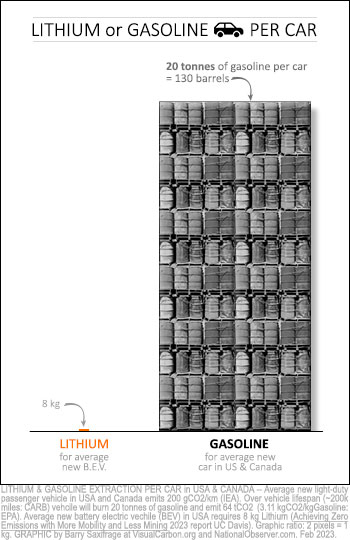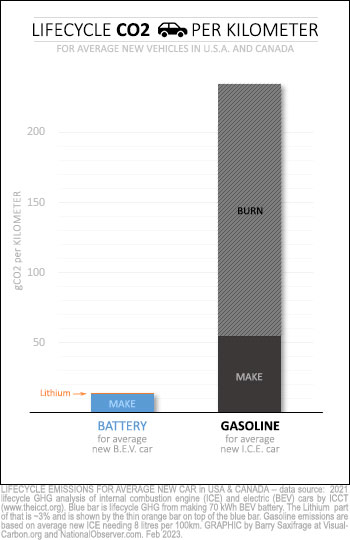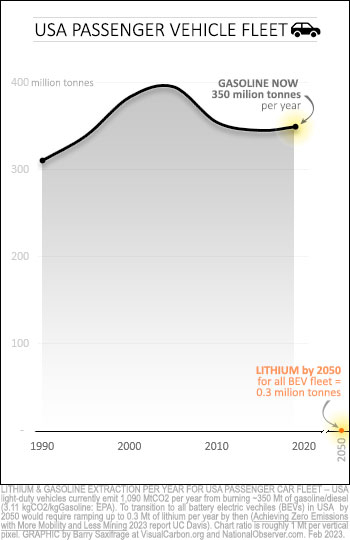Articles Menu

Feb. 8, 2023
More than a billion tonnes of climate pollution pours out American tailpipes every year. For scale, that's more than the combined emissions from the 100 least-polluting nations.
Ending this gargantuan climate pollution disaster will require a sharp increase in new lithium extraction to build the zero-emission alternatives — battery electric vehicles. A new report by the University of California, Davis and the Climate and Community Project (CCP) reveals just how much more lithium will be needed.
The CCP report calculates the lithium required to transition the entire United States passenger car fleet to battery electric vehicles (BEVs) by 2050. They evaluated several policy scenarios showing which would increase demand for lithium above "status quo" and which would dramatically reduce the amount needed. If you are interested in the environmental and social impacts of a rapid increase in lithium extraction — and the policies needed to reduce that harm — I recommend reading the CCP report.
In this article, I will focus on the other side of the coin, which the report didn't cover — the status quo gasoline alternative that Americans and Canadians buy today. I'll highlight the lithium numbers from the report to give a sense of the gargantuan scale of gasoline extraction today. (Note: In this article, I use the term "gasoline" to refer to both gasoline and diesel road fuels.)
My first graphic compares the amount of lithium required for each new BEV to the amount of gasoline required for each new internal combustion engine car (ICEV).

The CCP study found that the average new BEV bought in the United States requires eight kilograms of lithium. That's the orange bar on the left of the graphic.
All that lithium currently needs to come from new lithium extraction. However, the CCP study found this amount could be reduced dramatically in the future. For example, policies requiring lithium recycling and smaller batteries per vehicle could cut new lithium needed to as low as two kilograms per BEV by 2050.
In comparison, the average new fossil-burning passenger vehicle bought in Canada and the United States needs 20 tonnes of gasoline to move around. This is shown by the stack of oil barrels on the right. This gasoline weighs 10 times more than the car itself. And it's 2,500 times more massive than the lithium needed for each BEV.
All that gasoline must be extracted from the earth and refined as well. For example, much of the gasoline used in Canada and the U.S. comes from Alberta's gigantic bitumen mines with their sprawling, toxic tailings lagoons.
Ending the climate pollution disaster created by burning fossil fuels for vehicles will require a sharp increase in new lithium extraction to make vehicle batteries. @bsaxifrage writes for @NatObserver #lithium #EVs - Twitter
Unsurprisingly, extracting and refining huge amounts of gasoline results in huge amounts of climate pollution as well.
My second graphic compares the emissions from making gasoline and batteries.

The numbers come from a recent life-cycle analysis of BEVs and ICEVs by the International Council on Clean Transportation (ICCT).
The small blue bar on the left shows the climate pollution from making a battery for the average new BEV.
The lithium component is only around three per cent. It's shown by the thin orange part on the top.
The tall grey bar on the right is the gasoline needed for the average new ICEV in the United States or Canada. As you can see, just making gasoline causes four times more climate pollution than making a BEV battery.
Plus, this assumes the battery is scrapped when the car is. But the ICCT analysis says the average BEV battery still has about half its useful life remaining when the car itself wears out. As a result, many BEV batteries are getting reused to store electricity. This second use is reducing fossil fuel burning even further by allowing higher percentages of renewable energy in the electricity mix. If you include this second career for batteries in the life cycle analysis, then some of the battery emissions currently assigned to the BEV phase get shifted to that use.
In addition, recycling batteries can shrink their emissions even further. The CCP report and the ICCT analysis project large future declines in extraction impacts and life-cycle climate pollution from robust battery recycling.
So far, we've looked at amounts per vehicle. My final chart totals those up for the quarter billion passenger vehicles in the United States.

The black line on the top shows the amount of gasoline burned each year by all light-duty passenger vehicles in the United States — cars, vans, SUVs and pickup trucks.
They currently burn 350 million tonnes of gasoline per year. That's roughly a tonne of gasoline per American — extracted, refined, and burned every year.
According to the CCP report, to eliminate all that gasoline, lithium mining will need to rise to 0.3 million tonnes per year by 2050. That's shown by the orange dot in the lower right.
That's assuming the report's "status quo" scenario in which current BEVs simply replace all gasoline cars, without any change in recycling, battery size, or car ownership rates.
The CCP report questions whether lithium production can increase that much in the next 30 years. I don't know the details of lithium mining. But as the chart shows, in the last 30 years, gasoline extraction rose 100 times more than that. Humans, unfortunately, have proven to be remarkably capable of digging up what we want without enough regard for the consequences.
So, I applaud the CCP report for calling attention to the potential harms of the coming lithium boom. It points to the negative environmental and social impacts that come with all mining. And it highlights specific concerns with some of the planned lithium mining — including water scarcity, international conflicts, and trampling of Indigenous rights. I hope we adopt many of the CCP's policy recommendations to lessen those damages.
At the same time, I think it is critical to also inform the public about the many benefits that will come if we can rapidly eliminate climate pollution. In this case, those benefits include a massive decrease in the extraction of raw materials and the elimination of toxic automobile smog from our cities. And, of course, we gain a shot at passing along a decent and livable future for generations to come.
Right now, however, we are losing that climate fight. Badly.
When it comes to buying a new car, Americans and Canadians are still choosing fossil fuel burners 94 per cent of the time. That's well above even the global average. Our current preferences for gasoline burners are locking us into decades of massive gasoline demand, and all the harms that come with extracting and burning it.
And globally, fossil fuel burning and climate pollution just hit a record high. The atmospheric concentration of all three major greenhouse gases — carbon dioxide, methane and nitrous oxide — are also at record highs, and accelerating upwards.
----------------
Endnotes
For those wanting more details on gasoline and its climate impacts, here are some notes and links:
[Top:Illustration by Ata Ojani for Canada's National Observer]